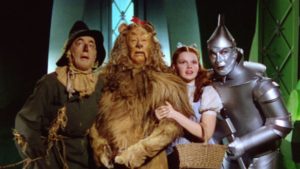
The Wizard of Oz is one of the most beloved and critically acclaimed movie musicals, which was released under MGM in 1938. MGM wanted to produce an adaptation of L. Frank Baum’s children’s story, The Wonderful Wizard of Oz, determined to make a prestigious fantasy picture to rival Disney’s Snow White and the Seven Dwarfs, which had premiered the year before (Rodman 128). Critical acclaim for the film was initially mixed. However, by the mid 1970s, the film had become firmly established in both scholarly and unscholarly American cultural discourse.
We follow an orphaned girl by the name of Dorothy Gale, who lives on a farm with her uncle, aunt and beloved dog, Toto. Only to be swept away by a tornado, up from the gray, impoverished lands of Kansas, landing in the magical land of Oz. At the cost of her arrival, Dorothy’s cabin causes the death of the Wicked Witch of the East, bringing much joy to the Munchkins but not so much to the Witch’s sister, the Wicked Witch of the West. With the only wish to go home and the help of the Good Witch of the North, Dorothy and Toto embark on a journey along the Yellow Brick Road, to find the Wizard of Oz himself in Emerald City. In the brink of her quest, Dorothy runs into and befriends three lovable individuals – a scarecrow who wants a brain, a tin man who yearns for a heart, and a lion who wishes for courage.
On the more technical side of things, camera techniques and special effects were crucial in creating the film. The videography of this film relies on many techniques but perhaps more heavily on the depth of field which is used to create a sense of relative space to each object in the setting. The rule of thirds is also used often to create mood and shift focus. Finally, this movie is infamous for its sounds. Both diegetic and non-diegetic sounds are used to create a sense of mood and and contrast. The Wizard of Oz uses filming elements including depth of field, the rule of thirds and non-diegetic sounds to establish the fantasy tone of the story. In addition to camera work, many physical production tools were utilized to bring the world of Kansas and Oz. For example, the tornado threatening Dorothy’s Kansas farmhouse was in fact a huge silk sticking twisted and coiling by a blowing fan. However, shots of the tornado at a far distance, seen in the film, used actual tornado footage. Another groundbreaking element to the film includes their considerable use of matte paintings. The most stunning example is the view of the Emerald City at the end of the Yellow Brick Road, as Dorothy and her group of friends finally arrive to see the Wizard of Oz.

One of the greatest elements of this film is not just the groundbreaking technology of color and music, but the themes around childhood that completely ground the characters and the world despite its whimsical features. The Wizard of Oz powerfully fills a void that exists inside many children. For kids of a certain age, home is everything, the center of the world if you will. But over the rainbow, is the wide earth, fascinating and terrifying. There is a deep fear that unpredictable events might occur after transporting the child from the safety of home and strand her or him far away in a strange land. And what would s/he hope to find there? New friends, to advise and protect them. New challenges, to educate and strength them. And their of course their pet dog, Toto as well.
The film’s theme touches on the key lesson of childhood – that someday the child will not be a child, that home will no longer exist, that adults will not be there to help because now the child is an adult and must face the challenges of life in the strange new land alone. But it also teaches you that you can always ask friends to help you. And that even the Wizard of Oz himself, the taunting “man” that every child fears in the new adult world, is only human, and has problems of his own.
The theme not only stops there but is critically portrayed within Dorothy’s friends on the Yellow Brick Road (the Tin Man, the Scarecrow, and the Lion). Her friends were projections of every child’s secret fears. Are we smart enough? What kind of person are we? Are we brave enough? Ultimately, in helping them, Dorothy was helping herself, just as a child who is learning the ropes of life overcoming their own fears by acting brave before another child.
This deep universal message explains why so many different people from many different backgrounds have a huge heart and treasured memory for The Wizard of Oz, including myself.
Sources:
https://www.rogerebert.com/reviews/great-movie-the-wizard-of-oz-1939
